

 Jewish Presence (4): Hessel Street & district
Jewish Presence (4): Hessel Street & district
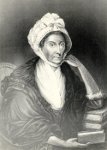 Hessel Street [previously Morgan Street, leading into Patriot Street], and Amazon Street
which runs
off it, are named for the 'Amazon of Stepney'. Phoebe Smith was born
locally in 1713. Masquerading as a man - or so she claimed - she
enlisted as a private in the 5th Regiment of Foot, probably to be near
her lover Samuel Golding (though other accounts say it was her father's
scheme so that she could stay with him after her mother's death). She
fought in the West Indies and Gibraltar, and was wounded in the Battle
of Fontenoy in 1745. At this point she revealed her secret to the
regimental colonel's wife - having previously told no-one, for you
know sir, a drunken man and a child always tell the truth. But I told
my story to the ground. I dug a hole that would hold a gallon and
whispered it there. She then married Golding; they settled
in Plymouth
and had nine children. When he died, she moved to Brighton and married
Thomas Hessel, a fisherman. After his death, she bought a donkey and
sold fish and vegetables in local villages, and in old age toys,
oranges and gingerbread near Brighton Pavilion. She wore a brown serge
dress with a clean white apron, a black hooded cloak, bonnet and mob
cap, and sported a large red handkerchief with white spots, and was
widely-known for her stories. She was rescued from the workhouse when
she was 95 by a pension of half a guinea a week from the Prince Regent,
and lived to a great age. The inscription on her headstone in St
Nicholas' churchyard, paid for by a local (Jewish) pawnbroker Hyam Lewis and later restored
by the Northumberland Fusiliers who considered her a member of their
regiment, reads
Hessel Street [previously Morgan Street, leading into Patriot Street], and Amazon Street
which runs
off it, are named for the 'Amazon of Stepney'. Phoebe Smith was born
locally in 1713. Masquerading as a man - or so she claimed - she
enlisted as a private in the 5th Regiment of Foot, probably to be near
her lover Samuel Golding (though other accounts say it was her father's
scheme so that she could stay with him after her mother's death). She
fought in the West Indies and Gibraltar, and was wounded in the Battle
of Fontenoy in 1745. At this point she revealed her secret to the
regimental colonel's wife - having previously told no-one, for you
know sir, a drunken man and a child always tell the truth. But I told
my story to the ground. I dug a hole that would hold a gallon and
whispered it there. She then married Golding; they settled
in Plymouth
and had nine children. When he died, she moved to Brighton and married
Thomas Hessel, a fisherman. After his death, she bought a donkey and
sold fish and vegetables in local villages, and in old age toys,
oranges and gingerbread near Brighton Pavilion. She wore a brown serge
dress with a clean white apron, a black hooded cloak, bonnet and mob
cap, and sported a large red handkerchief with white spots, and was
widely-known for her stories. She was rescued from the workhouse when
she was 95 by a pension of half a guinea a week from the Prince Regent,
and lived to a great age. The inscription on her headstone in St
Nicholas' churchyard, paid for by a local (Jewish) pawnbroker Hyam Lewis and later restored
by the Northumberland Fusiliers who considered her a member of their
regiment, reads|
In Memeory
of PHOEBE HESSEL who was born at Stepney in the Year 1713
She served
for many Years as a private soldier in the 5th Reg. of foot
in different parts of Europe
and in the
year 1745 fought under the
command of the DUKE of CUMBERLAND at the Battle of Fontenoy
where she
received a Bayonet wound in her Arm
Her long
life which commenced in
the time of QUEEN ANNE extended to the reign of GEORGE IV
by whose
munificence she received comfort and support in her latter Years
She
died at Brighton where she had long resided December 12th 1821 Aged 108
Years
|

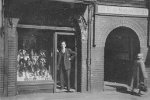
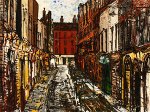
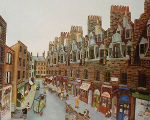 From the turn of the 20th century Hessel Street [left in 1936] became the site of the East End's
main Jewish market,
open every day except Saturdays. The narrow street was filled with
small shops and stalls. Chickens and
other poultry were kept in cages; buyers selected one, which was killed
according to kosher ritual and dressed while they shopped elsewhere (the archway, left, next to Carver's shoe shop at 9 Hessel Street led to 25-40 Morgan Houses and also to the abbatoir area).
There were also many wet fish stalls, and general shops, with pans and kettles hanging on
strings, and bookmakers. Some described it as an 'oriental' scene, the
last of the ghetto markets. See these highly pejorative comments from 1902. Right are
two idealised portraits: an artist's impression, looking towards
Commercial Road, and a drawing by Noel Gibson of around 1980 (long
after the street's heyday).
From the turn of the 20th century Hessel Street [left in 1936] became the site of the East End's
main Jewish market,
open every day except Saturdays. The narrow street was filled with
small shops and stalls. Chickens and
other poultry were kept in cages; buyers selected one, which was killed
according to kosher ritual and dressed while they shopped elsewhere (the archway, left, next to Carver's shoe shop at 9 Hessel Street led to 25-40 Morgan Houses and also to the abbatoir area).
There were also many wet fish stalls, and general shops, with pans and kettles hanging on
strings, and bookmakers. Some described it as an 'oriental' scene, the
last of the ghetto markets. See these highly pejorative comments from 1902. Right are
two idealised portraits: an artist's impression, looking towards
Commercial Road, and a drawing by Noel Gibson of around 1980 (long
after the street's heyday). In commenting on these and other cases, textbooks of the time said it
was all a matter of degree, even though small developments involving
two or three houses required permission under the Act. Hessel Street
was, of course, a more extensive development - but not as grandiose as
Davis' next
scheme, which was to create (with his brother Wolff) what today would
be a 'shopping mall', with
shops, reading rooms and steam baths, in Spitalfields. He took a lease
on what became Fashion Street Arcade, envisaging 250 shops; in the
event, when it
opened in 1909 there were only 69, fronted
by a Moorish design in pale red brick, dressed with moulded red brick
and terractotta and lavishly ornamented with cement [right]. It failed -
compare, rather more recently, Tobacco Dock - and he was bankrupted. It became workshops with
living accommodation above, but (having survived the Blitz and other
depradations) much of it has now been restored. See further Anne J. Kershen Strangers, Aliens & Asians: Huguenots, Jews and Bangladeshis in Spitalfields 1660-2000 (Psychology Press 2005) p56.
In commenting on these and other cases, textbooks of the time said it
was all a matter of degree, even though small developments involving
two or three houses required permission under the Act. Hessel Street
was, of course, a more extensive development - but not as grandiose as
Davis' next
scheme, which was to create (with his brother Wolff) what today would
be a 'shopping mall', with
shops, reading rooms and steam baths, in Spitalfields. He took a lease
on what became Fashion Street Arcade, envisaging 250 shops; in the
event, when it
opened in 1909 there were only 69, fronted
by a Moorish design in pale red brick, dressed with moulded red brick
and terractotta and lavishly ornamented with cement [right]. It failed -
compare, rather more recently, Tobacco Dock - and he was bankrupted. It became workshops with
living accommodation above, but (having survived the Blitz and other
depradations) much of it has now been restored. See further Anne J. Kershen Strangers, Aliens & Asians: Huguenots, Jews and Bangladeshis in Spitalfields 1660-2000 (Psychology Press 2005) p56.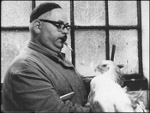
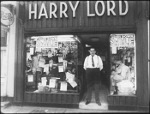
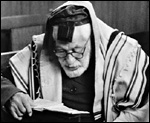
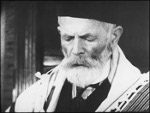 Vas, who had been
brought up in a Jewish ghetto in Nazi-occupied
Germany, was an advocate of the 'Free Cinema' technique. It was shot with
a lightweight 16mm camera and tape recorder and presents impressions of
the street, combinging long shots and close-ups over a background of
natural sounds, snatches of conversations
and old Yiddish songs; there is no voice-over commentary. It has a
lyrical and nostalgic quality. Authorised viewers can see the film on BFI
screenonline.
Vas, who had been
brought up in a Jewish ghetto in Nazi-occupied
Germany, was an advocate of the 'Free Cinema' technique. It was shot with
a lightweight 16mm camera and tape recorder and presents impressions of
the street, combinging long shots and close-ups over a background of
natural sounds, snatches of conversations
and old Yiddish songs; there is no voice-over commentary. It has a
lyrical and nostalgic quality. Authorised viewers can see the film on BFI
screenonline.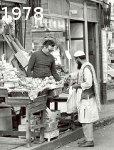
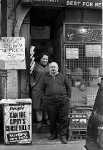
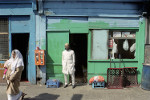
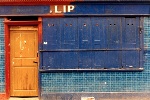
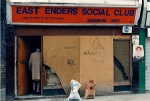
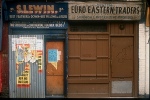 A few shops remained, in Jewish or increasingly Muslim hands - left is a greengrocer's in 1978, one offering eggs for both Passover and Easter, with signs in Arabic too, and a 1991 grocery shop. In 1988 Alan Dein photographed [right] derelict shopfronts to record the last moments of the
Jewish community in the area – the bustling world of the inter-war
years had been moved into the suburbs, and the community that stayed
behind was less identifiable. In the nineteen eighties they were just
hanging on, some premises had been empty for more than five years. Like
a mouthful of broken teeth, a boxer’s mouth that had been thumped, with
holes where teeth once were.
A few shops remained, in Jewish or increasingly Muslim hands - left is a greengrocer's in 1978, one offering eggs for both Passover and Easter, with signs in Arabic too, and a 1991 grocery shop. In 1988 Alan Dein photographed [right] derelict shopfronts to record the last moments of the
Jewish community in the area – the bustling world of the inter-war
years had been moved into the suburbs, and the community that stayed
behind was less identifiable. In the nineteen eighties they were just
hanging on, some premises had been empty for more than five years. Like
a mouthful of broken teeth, a boxer’s mouth that had been thumped, with
holes where teeth once were.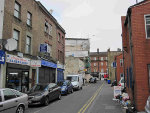 Left is
Hessel Street in 2011.
Left is
Hessel Street in 2011.
 From 1940-47 the Aufrichtig family, who had escaped from Austria, ran Robert's Restaurant at 2-4 Umberston Street [now the site of the popular, much-reviewed Lahore Kebab House] before it moved to 17 Commercial Road. Here are more details, from the fascinating family site run by Ronny Roberts (born Ronald Aufrichtig - left as a five-year old) - who has been in contact with us. He also runs this site about his wife's family, who had local connections for many years.
What by the 1970s had become the largest kosher bakery in Europe, J. Grodzinski & Daughters,
established by Lithuianian immigrants from Voronova, near Lida (now
Belarus), Harris and Judith Grodzinski, began nearby from a trading
barrow in 1888 (or soon after), then with a shop at 31 Fieldgate
Street, over which they lived, next to the Great
Synagogue (its site marked by a plaque on the wall); in due course they
had 18 outlets in London and elsewhere. Right is
an early photograph. Nephew Chaim Elyah Grodzinski (who married
Judith's sister Jessie) changed his name to Hyam Hyams; his sons Phil,
Sid and Mick became major developers of super-cinemas across London. Here
is a fascinating lecture about the project to transfer the Wurlitzer
organ from their 1930 Trocadero, at Elephant and Castle, to the Troxy
further along Commercial Road. 'Mr Phil' died, aged 102, in 1997.
From 1940-47 the Aufrichtig family, who had escaped from Austria, ran Robert's Restaurant at 2-4 Umberston Street [now the site of the popular, much-reviewed Lahore Kebab House] before it moved to 17 Commercial Road. Here are more details, from the fascinating family site run by Ronny Roberts (born Ronald Aufrichtig - left as a five-year old) - who has been in contact with us. He also runs this site about his wife's family, who had local connections for many years.
What by the 1970s had become the largest kosher bakery in Europe, J. Grodzinski & Daughters,
established by Lithuianian immigrants from Voronova, near Lida (now
Belarus), Harris and Judith Grodzinski, began nearby from a trading
barrow in 1888 (or soon after), then with a shop at 31 Fieldgate
Street, over which they lived, next to the Great
Synagogue (its site marked by a plaque on the wall); in due course they
had 18 outlets in London and elsewhere. Right is
an early photograph. Nephew Chaim Elyah Grodzinski (who married
Judith's sister Jessie) changed his name to Hyam Hyams; his sons Phil,
Sid and Mick became major developers of super-cinemas across London. Here
is a fascinating lecture about the project to transfer the Wurlitzer
organ from their 1930 Trocadero, at Elephant and Castle, to the Troxy
further along Commercial Road. 'Mr Phil' died, aged 102, in 1997.| 3427.
You went on to another place and stayed there some time?—After that
place I went and found a place in Umberston Street, Commercial Road.
I was working there about six months, and master lived there in two
underground kitchens. One kitchen used to be the workshop, and in the
back kitchen my master live with himself and his wife and his
children, and my master's wife had a sister, a single girl, who
slept in the workshop on a chair bed, and when I came in the morning
to work ... I had to knock at the door. Sometimes, like a female, she
had not got up quite so early,
and he said, 'Wait a minute', and I waited till they waked
the girl up and she left the place. I was working there six months.
3428. How many were there working there?—Two foreigners and the master. I worked there for six months, and afterwards I got ill working there late hours. 3429. What hours were you working?—Working till one o'clock in the morning, and sometimes till two, and every Thursday night all night. 3430. Was trade very brisk then?—Trade was. At that time what I recollect was eight or nine months busy during the year, and three or four months slack, but in the slack time a person had the chance of getting a bit. 3431. What wages were you earning at that place?—I used to earn from about 24s. to 25s. a week. 3432. What hours? From 8 o'clock in the morning, and I never left there before one the next morning, and sometimes two, and every Thursday all night. 3433. What was the work you were doing - finishing?—I was only doing the same work as I am doing now - slippers and dancing shoes.... |
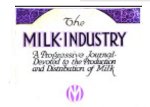
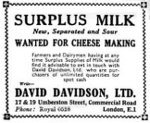 A local dairy
A local dairy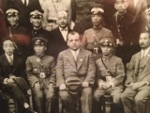
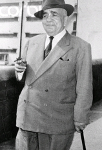 Morris Abraham 'Two-Gun' Cohen
(1887-1970), born in Poland, lived as a child in Umberston Street. He
had an intriguing life - he moved to Canada, was a boxer, supervised
Chinese workers and in 1922 became aide-de-camp to
Sun Yat-Sen, and later a major-general in the Chinese National
Revolutionary
Army. (He is said to have carried two guns, and to be able to shoot
with either hand.) He returned to Canada, and retired to Salford, where
his many
contacts brought him lucractive consultancies. He wrote a 1954
biography with Charles Drage (1954), but more accurate is Daniel S.
Levy Two-Gun Cohen: A Biography (1997). Gary Cooper's 1936 film The General Died at Dawn is based on his story, but he was turned into an Irish-American called O'Hara!
Morris Abraham 'Two-Gun' Cohen
(1887-1970), born in Poland, lived as a child in Umberston Street. He
had an intriguing life - he moved to Canada, was a boxer, supervised
Chinese workers and in 1922 became aide-de-camp to
Sun Yat-Sen, and later a major-general in the Chinese National
Revolutionary
Army. (He is said to have carried two guns, and to be able to shoot
with either hand.) He returned to Canada, and retired to Salford, where
his many
contacts brought him lucractive consultancies. He wrote a 1954
biography with Charles Drage (1954), but more accurate is Daniel S.
Levy Two-Gun Cohen: A Biography (1997). Gary Cooper's 1936 film The General Died at Dawn is based on his story, but he was turned into an Irish-American called O'Hara!